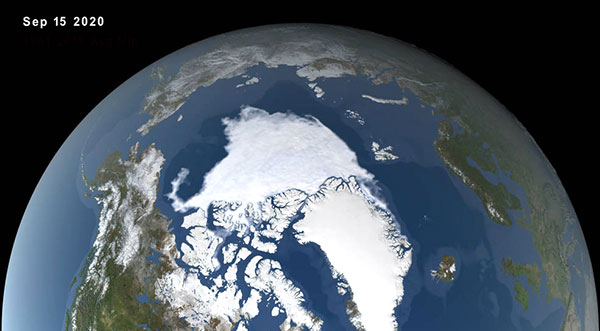NASA: 2020 Arctic Sea Ice Cover Shrank to Second-Lowest Extent Since Modern Record-Keeping
By NASA // September 22, 2020
The lowest extent on record was set in 2012
ABOVE VIDEO: NASA Sees High Temperatures, Wildfires, Sea Ice Minimum Extent in Warming Arctic.
(NASA) – This year’s Arctic sea ice cover shrank to the second-lowest extent since modern record-keeping began in the late 1970s.
An analysis of satellite data by NASA and the National Snow and Ice Data Center (NSIDC) at the University of Colorado Boulder shows that the 2020 minimum extent, which was likely reached on Sept. 15, measured 1.44 million square miles (3.74 million square kilometers).
In winter, frozen seawater covers almost the entire Arctic Ocean and neighboring seas. This sea ice undergoes seasonal patterns of change – thinning and shrinking during late spring and summer, and thickening and expanding during fall and winter.
The extent of summer sea ice in the Arctic can impact local ecosystems, regional and global weather patterns, and ocean circulation. In the last two decades, the minimum extent of Arctic sea ice in the summer has dropped markedly.
The lowest extent on record was set in 2012, and last year’s extent was tied for second – until this year’s.
“It was just really warm in the Arctic this year, and the melt seasons have been starting earlier and earlier,” said Nathan Kurtz, a sea ice scientist at NASA’s Goddard Space Flight Center in Greenbelt, Maryland. “The earlier the melt season starts, the more ice you generally lose.”

Thin ice also melts quicker than thicker floes. Dramatic drops in sea ice extent in 2007 and 2012, along with generally declining summer extent, has led to fewer regions of thick, multi-year ice that has built up over multiple winters.
In addition, a recent study showed that warmer water from the Atlantic Ocean, which is typically deep below the colder Arctic waters, is creeping up closer to the bottom of the sea ice and warming it from below.
“As the sea ice cover extent declines, what we’re seeing is we’re continuing to lose that multiyear ice,” Serreze said.
“The ice is shrinking in the summer, but it’s also getting thinner. You’re losing extent, and you’re losing the thick ice as well. It’s a double whammy.”
The second-lowest extent of sea ice on record is just one of many signs of a warming climate in the north, he said, pointing to the Siberian heat waves, forest fires, hotter-than-average temperatures over the Central Arctic, and the thawing permafrost that led to a Russian fuel spill.















